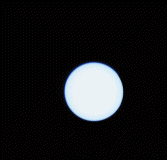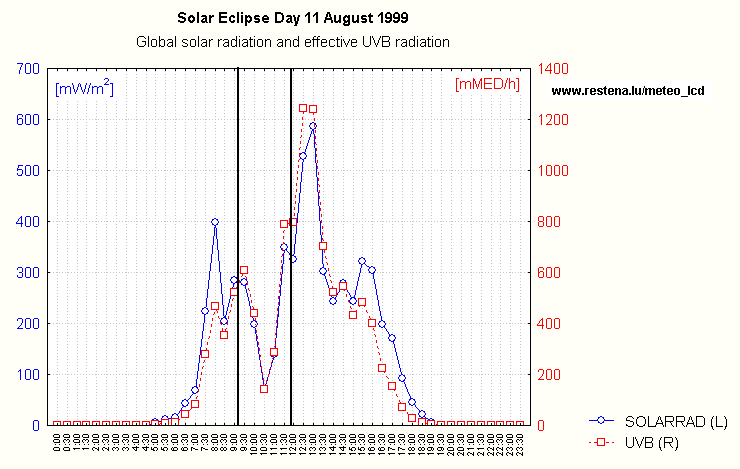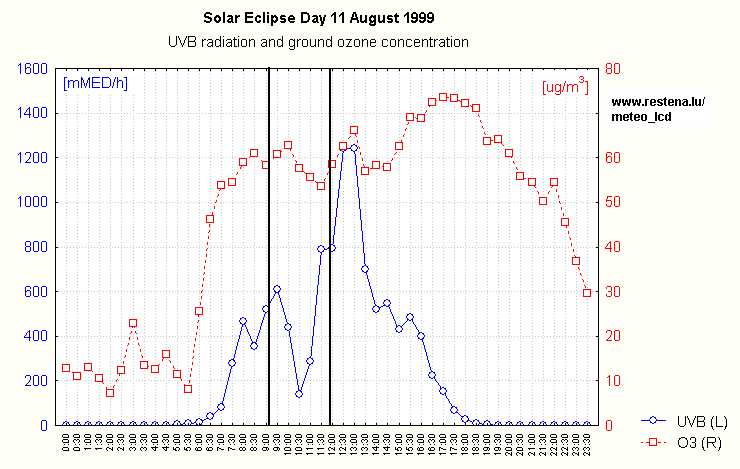
Meteorological Impact of
the 11th August 99 Solar Eclipse
Francis Massen
file: eclipse99.html
version 1.1 20 Mar 2015
(animated eclipse courtesy www.dwd.de)
 |
Meteorological Impact of
the 11th August 99 Solar Eclipse file: eclipse99.html |
1. Introduction
Luxembourg was "hit" by a solar eclipse on August 11th 1999; over the southern half of the country the eclipse was total, whereas the sun was covered by about 98% to 99% at Diekirch, the location of meteo_lcd.
The eclipse started at Diekirch at 09:09:41 (UTC) and ended at 13:51:00 (UTC); maximum occultation was at 12:29:01.
In this concise report, we will look how different meteorological parameters changed during the dimming of the sun. It should be remembered that the measurements at meteo_lcd are done every minute, the mean of 30 readings being stored at the end of a 30 minutes period. A data-point located at 10:30 represents the mean of the readings done between 10:00 and 10:29. This rather large averaging period "swallows" and/or "smears-out" short time variations!
The overall meteorological conditions were very poor: the sky was absolutely not clear during the whole eclipse period, with a moderate to heavy cloud cover present most of the time. Fortunately the cloud cover became thin enough during many moments to see the solar crescent. However the cloud cover remained so thick that looking at the solar crescent was possible without any protective glasses or other devices. From time to time, a patch of blue sky gave a good view (this time protective glasses were mandatory) to the sun.
2. The data
 |
Global solar radiation and effective UVB
radiation The graph clearly shows the inverse peak corresponding to the maximum occultation at 10:30 UTC. The minimum values are not zero: this is first due to the "smearing-out" of the averaging, and secondly to the eclipse being not quite total at Diekirch. At this time of the year, an absolute blue sky gives an effective UVB reading between 2000 and 2500 mMED/h for the full sun. |
 |
UVB radiation and ground ozone concentration As expected, the ozone concentration drops when the UVB radiation dims and practically vanishes at 10:30. There is a time lag of about one hour between the moments of minimum UVB and minimum ozone concentration |
|
Air temperature and atmospheric pressure The air temperature falls about 0.7 şC during the eclipse: minimum is certainly reached some time after maximum occultation: the sampling period of meteo_lcd allows only to conclude that the time lag is smaller than 30 minutes. Atmospheric pressure increases a little due to the higher density of colder air. |
 |
Air temperature and wind speed Often solar eclipses go together with a more or less strong wind being produced by the pressure differences between the locally cooled down air and the more or less constant temperature of the air outside the shadow-zone. Here the cooling down is too small to produce a clearly measurable effect! |
3. Conclusions
The poor sky condition prevented extreme variations in temperature and wind speed. The solar eclipse affected UVB and ozone values in a predictable manner. Whereas the influence of the black sun clearly shows up in the data, no spectacular, unexpected happening occured, and the world continued as usual....